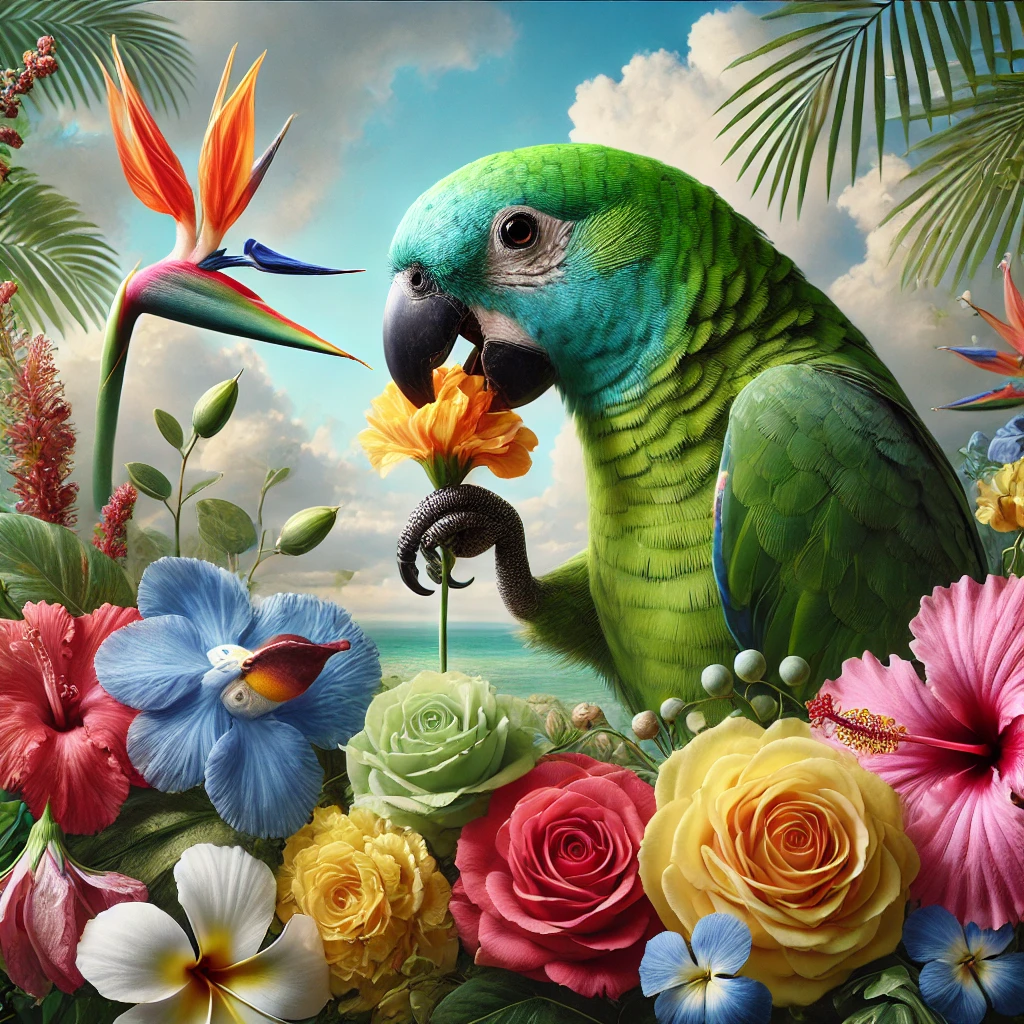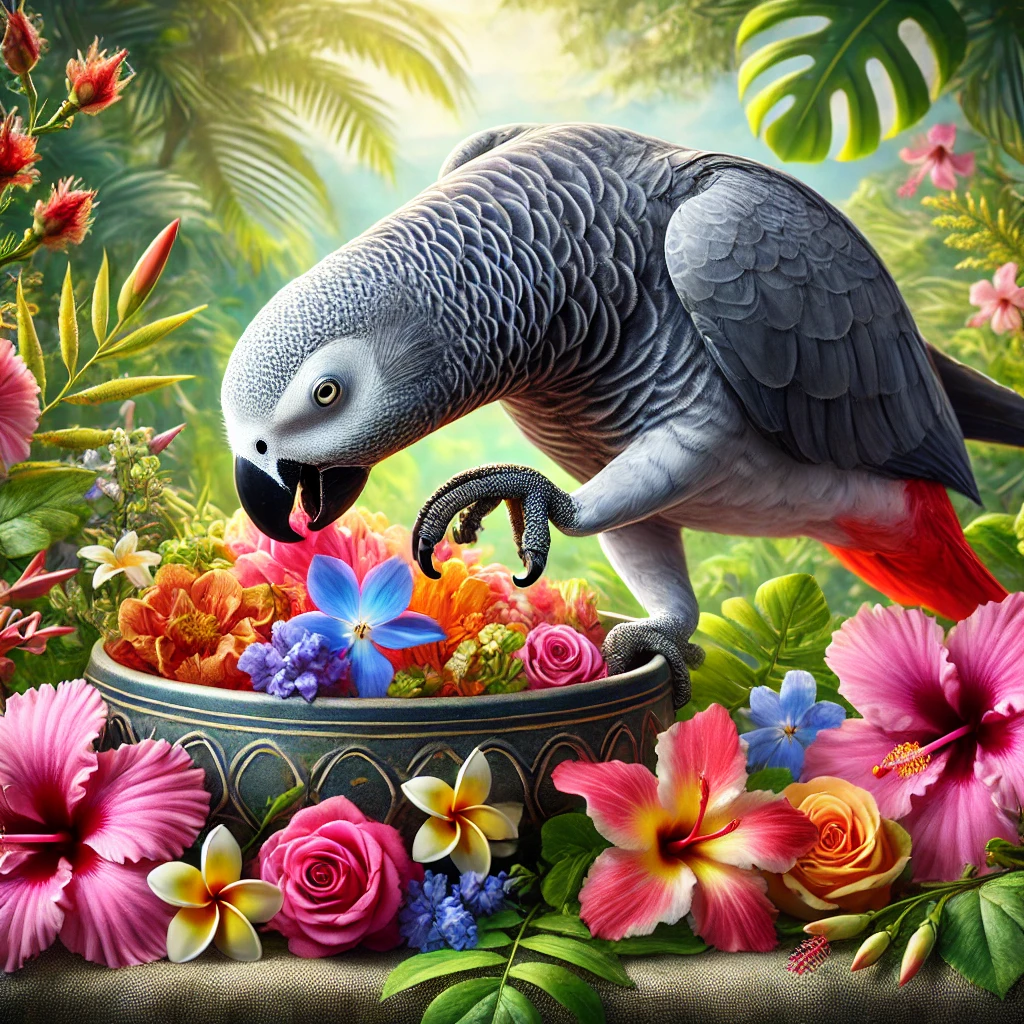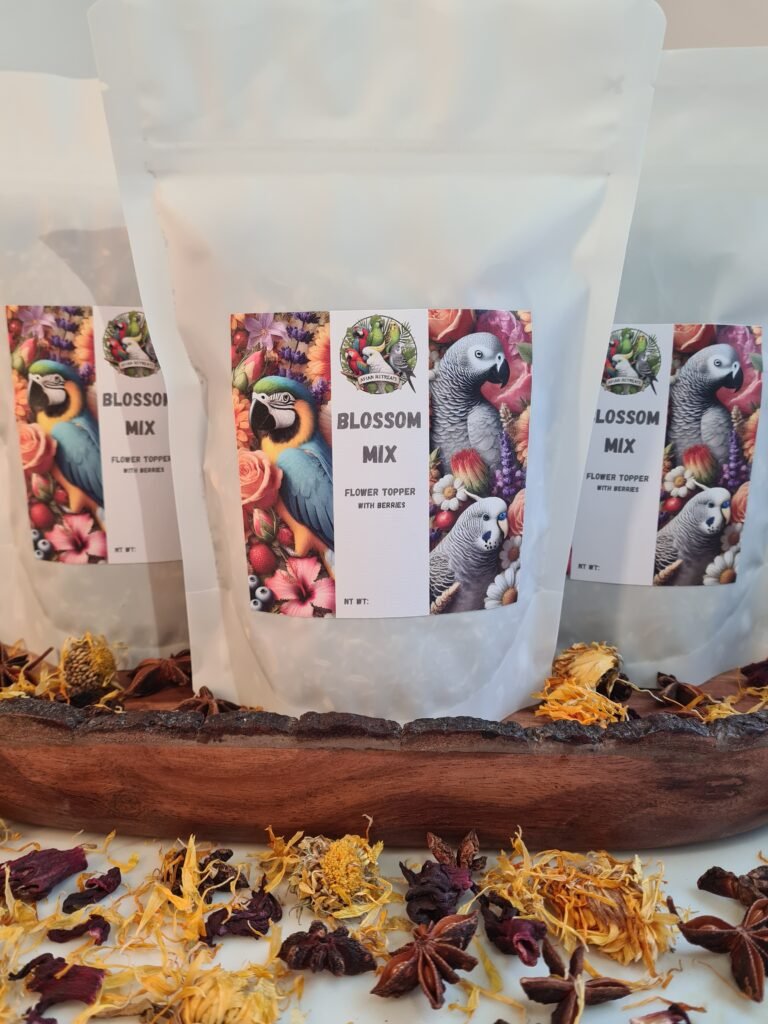When it comes to enhancing a parrot’s diet, flowers are a vibrant, nutritious, and enriching addition. In the wild, many parrots forage for flowers as part of their natural diet, consuming petals, nectar, pollen, and even seeds. This guide provides a comprehensive look at the role of flowers in your parrot’s diet, exploring their nutritional benefits, safe options, how to serve them, and whether fresh or dried flowers are the best choice.

In their natural habitats, parrots often consume flowers alongside fruits, nuts, seeds, and foliage. Flowers offer a unique combination of nutrients, flavours, and textures that stimulate foraging behaviours and support overall health.
Dr. Susan Clubb, a renowned avian veterinarian, states, “Flowers provide parrots with essential nutrients and an enrichment experience, mirroring their natural eating habits in the wild.” Including flowers in your parrot’s diet not only offers a nutritional boost but also keeps them mentally engaged.
Flowers are a natural source of essential vitamins, minerals, and antioxidants. Here’s a breakdown of their key nutrients and the roles they play in a parrot’s health:
Vitamin A: Supports immune function, vision, and feather quality.
Vitamin C: Boosts immunity and helps combat stress.
Vitamin E: Protects cells from oxidative damage and supports skin and feather health.
Calcium: Vital for strong bones, muscle function, and egg production in females.
Magnesium: Supports energy production, nerve function, and calcium absorption.
Iron: Aids in oxygen transport and energy metabolism (to be monitored in iron-sensitive species like African Greys).
Potassium: Helps regulate fluid balance and muscle contractions.
Zinc: Strengthens the immune system, promotes feather growth, and supports wound healing.
Phosphorus: Essential for bone health and energy production.
Manganese: Plays a role in bone formation and antioxidant defence.
Brightly coloured flowers like hibiscus, calendula, and marigolds are rich in antioxidants, which help combat free radicals and reduce inflammation.
The petals, stems, and other parts of flowers provide dietary fibre, aiding digestion and promoting gut health.
Not all flowers are safe for parrots. It’s essential to ensure any flowers offered are non-toxic and pesticide-free. Here’s a list of safe options and their benefits:
| Flower | Nutritional Benefits | Why It’s Good |
|---|---|---|
| Hibiscus | High in vitamin C and antioxidants | Supports immune health and skin condition |
| Dandelion | Rich in calcium, vitamin A, and fibre | Promotes bone health and aids digestion |
| Calendula | Contains flavonoids and carotenoids | Improves feather condition and reduces inflammation |
| Rose Petals | High in vitamin C and natural antioxidants | Enhances immunity and adds a pleasant aroma to meals |
| Chamomile | Contains calming compounds and antioxidants | Reduces stress and supports digestion |
| Lavender | Contains essential oils with soothing properties | Calms nervous birds and provides mild antibacterial benefits |
| Marigold | Rich in lutein and zeaxanthin | Supports eye health and reduces oxidative stress |
| Zinnia | Provides vitamins and minerals | Adds variety and enrichment |
| Nasturtium | High in vitamin C and sulphur compounds | Enhances feather health and acts as a natural antibacterial agent |
| Bee Balm | Rich in antioxidants and vitamins | Supports immunity and offers a sweet aroma |
| Sunflowers | High in vitamin E and fibre | Promotes healthy digestion and feather health |
| Clover Blossoms | Contains antioxidants, calcium, and vitamins | Supports overall health and encourages foraging behaviours |
| Bougainvillea | Rich in antioxidants and low in calories | Adds variety and supports a healthy immune system |
| Honeysuckle | Provides nectar and natural sugars (flower only) | Encourages hydration and foraging |
| Cornflowers | High in antioxidants | Reduces inflammation and supports feather health |
| Snapdragons | Rich in vitamins and minerals | Encourages foraging and adds dietary variety |
| Petunias | Contain small amounts of vitamins | Adds variety and enrichment to a parrot’s diet |
| Moringa Flowers | High in calcium, protein, and vitamins | Strengthens bones and supports overall health |
| Chicory Flowers | Rich in fibre and mild antioxidants | Improves digestion and provides enrichment |

Some flowers are toxic to parrots and should never be offered:
Oleander
Foxglove
Lily (all types)
Daffodil
Tulip
Hydrangea
Buttercup
Morning Glory
| Aspect | Fresh Flowers | Dried Flowers |
| Water Content | High; helps with hydration | Low; may require rehydration |
| Shelf Life | Short; needs to be used quickly | Long; can last for months |
| Nutrient Retention | Fully intact nutrients | Concentrated nutrients; some vitamins may degrade |
| Convenience | Requires rinsing and preparation | Ready to use; easy to store |
| Enrichment Potential | Great for foraging and shredding | Less physical enrichment, but still engaging when mixed with food |
Mix with Chop: Add chopped fresh or dried flowers to your parrot’s fresh vegetables and grains.
Rehydrate Dried Flowers: Soak dried flowers in warm water for a few minutes to restore some of their natural texture and hydration.
Make Flower Bouquets: Create small bouquets with safe flowers for your parrot to explore and shred.
Foraging Toys: Stuff flowers into foraging toys to encourage natural behaviours.
Flowers should make up about 5-10% of your parrot’s overall diet. They are a supplement to pellets, seeds, vegetables, and fruits—not a primary food source. Always introduce flowers gradually and observe your parrot’s reaction to ensure they tolerate them well.

Flowers are a natural and enriching addition to your parrot’s diet. Whether fresh or dried, they provide essential nutrients, hydration, and mental stimulation. By selecting safe, pesticide-free options and offering them in moderation, you can enhance your parrot’s overall well-being and mimic their natural foraging habits.
Looking for a convenient way to add flowers to your parrot’s meals? At Avian Retreats, we offer a premium flower-based topper mix called Blossom Mix. It’s an easy and enriching way to introduce safe, dried flowers into your parrot’s diet.
Researching the flowers you plan to introduce is essential to ensure they are safe and beneficial for your parrot. With careful selection and preparation, flowers can become a vibrant and healthy part of your parrot’s meals.
